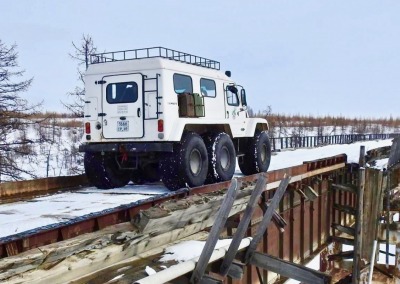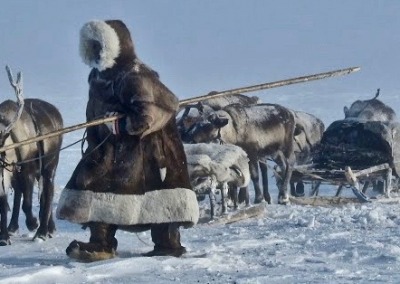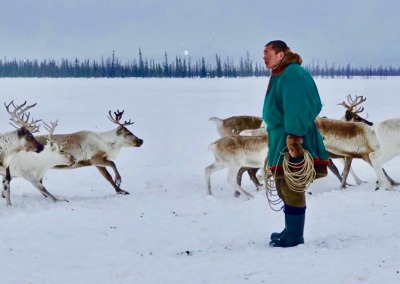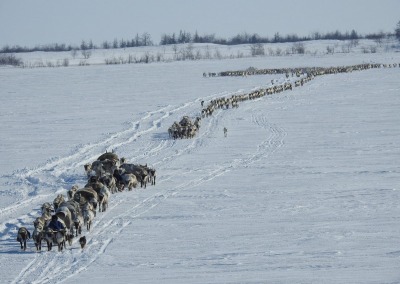Northern Lights
The Northern Lights, also known as the Aurora Borealis (or Kharp in the Nenets language) is a spectacular natural light display that occurs only at the world’s northernmost latitudes. It is caused when the solar wind causes particles in the magnetosphere to collide and become ionised. They emit a light that is most often a dull green colour but that can, if you are lucky, become much brighter. Less commonly, the Northern Lights can be red and purple. Even more rarely they can be yellow and blue.
Sometimes they are seen as just a glowing patch in one part of the sky. Other times they cover almost the whole sky. Often they begin forming tendrils, rippling curtains of light or shooting rays that explode across the sky as you watch them. Old Nenets legends say that these are caused by arrows fired by the souls of their ancestors who come out to hunt at night.
The Northern Lights can be seen from late August until late April. However, seeing them in either August or April is not that common. The very best time is from December to February.
To have the best chances of seeing the Northern Lights there needs to be
as little other light as possible in the sky. There are three main ways to do this:
- Try to plan your trip to coincide with the New Moon
- Get as far away as possible from any towns, villages or other sources of artificial light (this makes Nenets encampments the perfect place)
- Go out to check for the Northern Lights when it is completely dark, at the time of night referred to as astronomical twilight.
Another way to increase your chances of seeing the Northern Lights is to go as far north as possible. This makes the Seyakha area the best area on the Yamal Peninsula. However, if Northern Lights are a priority but you do not want to go all the way to Seyakha, please let us know. We can send you to the northernmost encampments of the Yar-Sale Nenets as a very good alternative. Alternatively you could visit the very remote Yorkuta Nenets on the western coast of the Yamal Peninsula, who are around 250km north of the Arctic Circle in winter. Towns like Nadym, Salekhard and the Polar Ural Mountains are on or slightly south of the Arctic Circle, so chances of seeing the Northern Lights there are lower.
The Northern Lights, also known as the Aurora Borealis (or Kharp in the Nenets language) is a spectacular natural light display that occurs only at the world’s northernmost latitudes. It is caused when the solar wind causes particles in the magnetosphere to collide and become ionised. They emit a light that is most often a dull green colour but that can, if you are lucky, become much brighter. Less commonly, the Northern Lights can be red and purple. Even more rarely they can be yellow and blue.
Sometimes they are seen as just a glowing patch in one part of the sky. Other times they cover almost the whole sky. Often they begin forming tendrils, rippling curtains of light or shooting rays that explode across the sky as you watch them. Old Nenets legends say that these are caused by arrows fired by the souls of their ancestors who come out to hunt at night.
The Northern Lights can be seen from late August until late April. However, seeing them in either August or April is not that common. The very best time is from December to February.
To have the best chances of seeing the Northern Lights there needs to be as little other light as possible in the sky. There are three main ways to do this:
- Try to plan your trip to coincide with the New Moon
- Get as far away as possible from any towns, villages or other sources of artificial light (this makes Nenets encampments the perfect place)
- Go out to check for the Northern Lights when it is completely dark, at the time of night referred to as astronomical twilight.
Another way to increase your chances of seeing the Northern Lights is to go as far north as possible. This makes the Seyakha area the best area on the Yamal Peninsula. However, if Northern Lights are a priority but you do not want to go all the way to Seyakha, please let us know. We can send you to the northernmost encampments of the Yar-Sale Nenets as a very good alternative. Alternatively you could visit the very remote Yorkuta Nenets on the western coast of the Yamal Peninsula, who are around 250km north of the Arctic Circle in winter. Towns like Nadym, Salekhard and the Polar Ural Mountains are on or slightly south of the Arctic Circle, so chances of seeing the Northern Lights there are lower.




